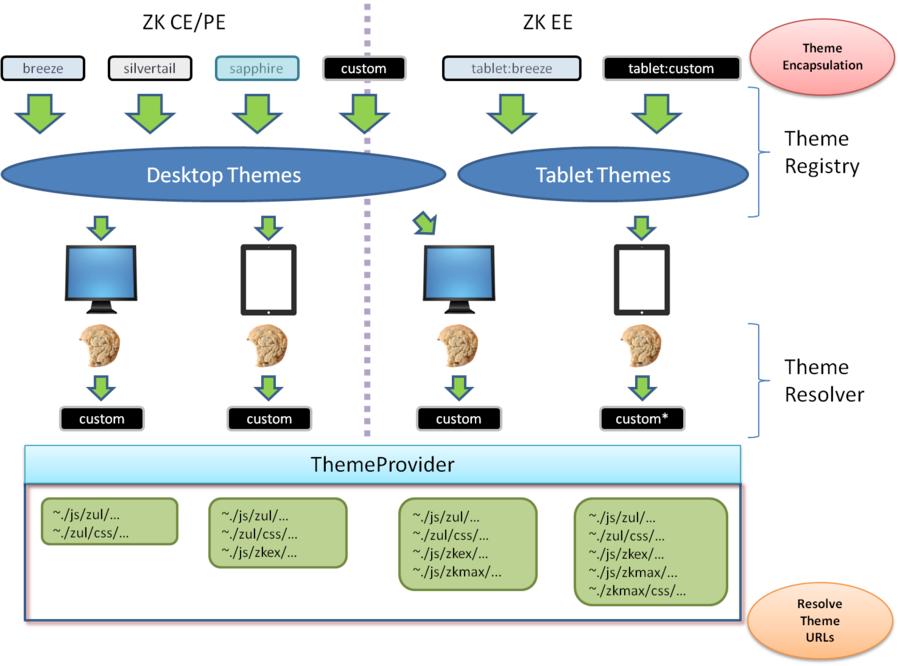Understanding the Theming Subsystem"
RebeccaLai (talk | contribs) m |
|||
| (13 intermediate revisions by one other user not shown) | |||
| Line 1: | Line 1: | ||
{{ZKDevelopersReferencePageHeader}} | {{ZKDevelopersReferencePageHeader}} | ||
| − | + | The collection of the components' stylesheets and associated images is called a theme. Themes control the overall look and feel of a page composed of ZK components. For example, the components using the standard sapphire theme will all follow the same blue-ish color scheme. | |
| − | + | Starting from ZK 6.5.2, supporting different themes takes a more modularized approach. '''Theme Support Subsystem''' breaks up into a few pluggable modules: '''ThemeRegistry''', '''ThemeResolver''', and '''ThemeProvider'''. ThemeRegistry keeps track of a list of available themes to use. ThemeResolver is responsible for setting and obtaining the current theme. ThemeProvider allows web developers to manipulate the CSS stylesheets actually employed to style the UI components. Customizing these modules enables web developers to modify any part of the theme processing pipeline to fit their particular requirement. | |
| − | + | '''Theme Support Subsystem''' is illustrated by the figure below. In addition to the three pluggable modules, there also exist facilities to encapsulate theme information and resolve URLs for locating theme resources. | |
| − | + | Please refer to the subsections for more information on the constituent parts. | |
| − | + | [[File:ThemeSubsystem.png|900px]] | |
| − | + | {{ZKDevelopersReferenceHeadingToc}} | |
| − | |||
| − | |||
| − | |||
| − | |||
| − | |||
| − | |||
| − | |||
| − | |||
| − | |||
| − | |||
| − | |||
| − | |||
| − | |||
| − | |||
| − | |||
{{ZKDevelopersReferencePageFooter}} | {{ZKDevelopersReferencePageFooter}} | ||
Latest revision as of 09:33, 31 January 2024
The collection of the components' stylesheets and associated images is called a theme. Themes control the overall look and feel of a page composed of ZK components. For example, the components using the standard sapphire theme will all follow the same blue-ish color scheme.
Starting from ZK 6.5.2, supporting different themes takes a more modularized approach. Theme Support Subsystem breaks up into a few pluggable modules: ThemeRegistry, ThemeResolver, and ThemeProvider. ThemeRegistry keeps track of a list of available themes to use. ThemeResolver is responsible for setting and obtaining the current theme. ThemeProvider allows web developers to manipulate the CSS stylesheets actually employed to style the UI components. Customizing these modules enables web developers to modify any part of the theme processing pipeline to fit their particular requirement.
Theme Support Subsystem is illustrated by the figure below. In addition to the three pluggable modules, there also exist facilities to encapsulate theme information and resolve URLs for locating theme resources.
Please refer to the subsections for more information on the constituent parts.
